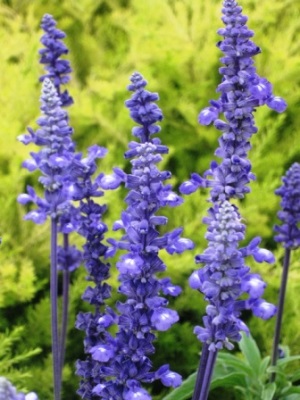 Salvia 'Victoria' Picture courtesy www.steyns-nursery.co.zaCondensed Version:
Salvia 'Victoria' Picture courtesy www.steyns-nursery.co.zaCondensed Version:
There are hundreds of different types of salvias available to gardeners, and they all have beautiful tall flower spikes, and attractive green or grey-green leaves which are often aromatic. They will flower almost all summer and autumn, and new selections come out almost every season, which are valued for their extended blooming season and spires of dense or loose flowers in shades of red and pink, or bright blue, violet, cream and white. Tall and dwarf varieties are available, varying in height and spread from +-15 to 90cm tall. Although the summer flowering annual salvias (Salvia splendens) are well known and loved by gardeners, perennial salvias have become mainstays of the summer garden, providing season long colour at very little expense. The taller varieties of sage will add accent to flowerbeds and the dwarf varieties make excellent border plants and work well in containers, mixed with other summer flowering annuals. Butterflies as well as nectar eating birds are drawn like magnets to salvias.
Mexican Bush Sage, Velvet Sage (Salvia leucantha) is a spreading shrub with soft, narrow, wrinkled leaves that are pale green on top and woolly and silver-white underneath. In spring long sprays of white flowers appear, contrasting beautifully with the velvety purple calyces. This salvia blooms abundantly in spring, intermittently in summer, and then again with renewed vigour in autumn. Use Mexican bush sage in mixed borders along with rosemary, buddleia, and other salvias like blue anise sage or autumn sage.
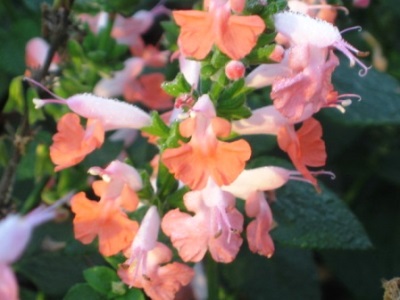 Salvia greggii 'Coral' Picture courtesy www.steyns-nursery.co.zaAutumn Sage, Cherry Sage (Salvia greggii hybrids) is a highly variable plant, with numerous named cultivars, and varying in height from +-30cm to 1.22m, and less in width. Its growth habit can be either upright or mounding; and it’s mid-green leaves have a minty fragrance. Contrary to its common name, it blooms throughout the summer and autumn, until the first frosts. Flower size and colour range have been enhanced by breeding, resulting in many cultivars which include many shades of scarlet and red, which is the most common colour found in the wild; as well as rose, pink, salmon, lavender, pale yellow, apricot, violet and white. Autumn sage is a popular water-wise plant for hot, dry areas because it blooms for so long and is delightful to use as a small, ornamental, flowering shrub in a perennial bed or even as a low hedge.
Salvia greggii 'Coral' Picture courtesy www.steyns-nursery.co.zaAutumn Sage, Cherry Sage (Salvia greggii hybrids) is a highly variable plant, with numerous named cultivars, and varying in height from +-30cm to 1.22m, and less in width. Its growth habit can be either upright or mounding; and it’s mid-green leaves have a minty fragrance. Contrary to its common name, it blooms throughout the summer and autumn, until the first frosts. Flower size and colour range have been enhanced by breeding, resulting in many cultivars which include many shades of scarlet and red, which is the most common colour found in the wild; as well as rose, pink, salmon, lavender, pale yellow, apricot, violet and white. Autumn sage is a popular water-wise plant for hot, dry areas because it blooms for so long and is delightful to use as a small, ornamental, flowering shrub in a perennial bed or even as a low hedge.
Mealy Blue Sage, Mealy Sage, Mealycup Sage, Blue Sage (Salvia farinacea) There are several garden cultivars that differ in size and flower colour. Cultivars vary in size from
+-30cm to 1.2m tall.
Blou Salie 'Victoria' (Salvia farinacea) produces beautifully showy deep blue flowers from spring until autumn if the dying flowers are kept trimmed off.
Salvia Mystic 'Spires Blue' (Salvia longispicata x farinacea blooms from spring all the way through to autumn; and the dark grey-green leaves are a perfect foil for the showy purple-blue flowers.
Anise Sage 'Black and Blue' (Salvia guaranitica) has startlingly bright, cobalt-blue flower spikes which are framed by black calyces and stems; appearing from mid-summer and continuing deep into autumn. This salvia is a wonderful background plant, creating a brilliant display in landscapes and flower borders.
Pineapple Sage, Pynappelsalie (Salvia elegans) is spectacular when in full bloom with its masses of tubular, blood red flower spikes that contrast perfectly against the bright green leaves. The leaves have a wonderful fresh pineapple scent when crushed. Mass plantings of Pineapple Sage will create a striking splash of colour, but even single specimens look great in the shrub or perennial border. It also grows well in larger pots if it is clipped regularly and the soil is very well drained.
Salvias do well in most of our growing regions and perform extremely well in hot gardens. Although they are drought tolerant, to look at their best they should be watered moderately during long hot and dry spells. They thrive in full sun but will take light shade; and in regions which experience extremely hot weather, the plants will appreciate some shade during the hottest time of the day. Although there are salvias suitable for almost all climates, take care when choosing them because not all salvias are hardy in all regions, and extreme frost is fatal to them. Moderate frost may damage them but they usually recover quickly with the onset of warmer weather. For this reason, with the exception of those frost-free and humid regions, salvias are often grown as summer annuals.
Salvias grow well in sandy loam soils with perfect drainage, but will adapt to most garden soils, but it is vital that the soil drains well to prevent root rot. Salvias are not hungry plants and overly fertile soils, or too much fertiliser will actually reduce flowering, so feed only once a season in spring, and mulch the roots with fresh compost. If you cut back your plants back lightly after each flush of flowers, new growth will soon emerge, and your plants will bloom almost continually. Just before winter sets in is the best time to prune them back sharply and to renew the organic mulch around their root systems if you want to protect them from the cold.
Full Version:
Description, History & Interesting Facts:
Salvia is commonly referred to as sage, and is the largest genus in the mint family (Lamiaceae); and includes annuals, perennials and soft-wooded evergreen shrubs; as well as culinary and medicinal herbs and garden ornamentals. The genus has approximately 900 species and is distributed throughout the Old World and the Americas, with three distinct regions of diversity: Central and South America has about 500 species; Central Asia and the Mediterranean 250 species, and Eastern Asia with about 90 species. More than half of the species of Salvia are native to the Americas, occurring in a wide range of habitats, from coastal to alpine. There are hundreds of different types of salvias available to gardeners, and they all have beautiful tall flower spikes, and attractive green or grey-green leaves which are often aromatic. They will flower almost all summer and autumn, and new selections come out almost every season, which are valued for their extended blooming season and spires of dense or loose flowers in shades of red and pink, or bright blue, violet, cream and white. Tall and dwarf varieties are available, varying in height and spread from +-15 to 90cm tall. Although the summer flowering annual salvias (Salvia splendens) are well known and loved by gardeners, perennial salvias have become mainstays of the summer garden, providing season long colour at very little expense. The taller varieties of sage will add accent to flowerbeds and the dwarf varieties make excellent border plants and work well in containers, mixed with other summer flowering annuals. Butterflies as well as nectar eating birds are drawn like magnets to salvias.
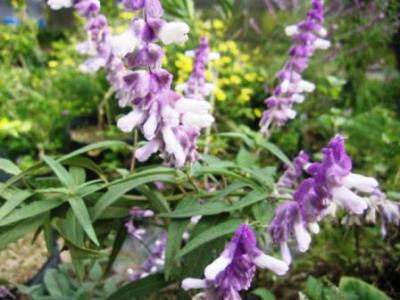 Salvia leucantha. Picture courtesy www.steyns-nursery.co.zaMexican Bush Sage, Velvet Sage (Salvia leucantha) is a semi-evergreen herbaceous perennial which is native to Central America and Mexico. It is a spreading shrub with soft, narrow, wrinkled leaves that are pale green on top and woolly and silver-white underneath. In early winter it becomes totally deciduous for a few months, but new growth appears again in midwinter. In spring, long sprays of white flowers appear, contrasting beautifully with the velvety purple calyces. This salvia blooms abundantly in spring, intermittently in summer, and then again with renewed vigour in autumn. Use Mexican bush sage in mixed borders along with rosemary, buddleia, and other salvias like blue anise sage or autumn sage. The flowers of this sage can also be used as a cut-flower and the flowers are very long lasting. Its soft greyish foliage is attractive all summer long as an accent to the other shrubs that are blooming; then in the autumn when most of the other shrubs are getting tired, Mexican bush sage comes into its own. This sage thrives in hot and dry Mediterranean and subtropical gardens; performing well in sandy soils, and tolerating periods of drought with ease. Although it is considered tender to frost it will take light frost if planted in a protected place in the garden. It loves full sun but will take some shade, and generally grows +-1m tall and 1m wide, but can reach 1.3m tall with a 2m spread if left unpruned. Although this plant tolerates some drought, it will look at its best in the garden if watered moderately during very dry, hot spells. As it flowers, the plant spreads outward and is subject to fall over and break off stems. Remove flower clusters as they age to reduce the weight on the stems. The best time to cut it back into shape would be right after it has finished blooming in autumn and before it becomes dormant in winter, but it can also be pruned in early summer.
Salvia leucantha. Picture courtesy www.steyns-nursery.co.zaMexican Bush Sage, Velvet Sage (Salvia leucantha) is a semi-evergreen herbaceous perennial which is native to Central America and Mexico. It is a spreading shrub with soft, narrow, wrinkled leaves that are pale green on top and woolly and silver-white underneath. In early winter it becomes totally deciduous for a few months, but new growth appears again in midwinter. In spring, long sprays of white flowers appear, contrasting beautifully with the velvety purple calyces. This salvia blooms abundantly in spring, intermittently in summer, and then again with renewed vigour in autumn. Use Mexican bush sage in mixed borders along with rosemary, buddleia, and other salvias like blue anise sage or autumn sage. The flowers of this sage can also be used as a cut-flower and the flowers are very long lasting. Its soft greyish foliage is attractive all summer long as an accent to the other shrubs that are blooming; then in the autumn when most of the other shrubs are getting tired, Mexican bush sage comes into its own. This sage thrives in hot and dry Mediterranean and subtropical gardens; performing well in sandy soils, and tolerating periods of drought with ease. Although it is considered tender to frost it will take light frost if planted in a protected place in the garden. It loves full sun but will take some shade, and generally grows +-1m tall and 1m wide, but can reach 1.3m tall with a 2m spread if left unpruned. Although this plant tolerates some drought, it will look at its best in the garden if watered moderately during very dry, hot spells. As it flowers, the plant spreads outward and is subject to fall over and break off stems. Remove flower clusters as they age to reduce the weight on the stems. The best time to cut it back into shape would be right after it has finished blooming in autumn and before it becomes dormant in winter, but it can also be pruned in early summer.
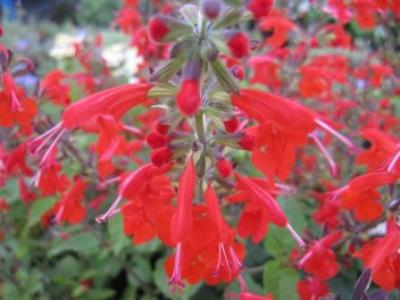 Salvia 'Lady in Red' Picture courtesy www.steyns-nursery.co.zaAutumn Sage, Cherry Sage (Salvia greggii hybrids) is an evergreen herbaceous perennial which is native to a long, narrow area from southwest Texas, through the Chihuahuan Desert and into the Mexican state of San Luis Potosi, typically growing in rocky soils at elevations from 1,500 to 2,700m. This salvia is a highly variable plant, with numerous named cultivars, and varying in height from +-30cm to 1.2m, and less in width. Its growth habit can be either upright or mounding; and it’s mid-green leaves have a minty fragrance. Contrary to its common name, it blooms throughout the summer and autumn, until the first frosts. Flower size and colour range have been enhanced by breeding, resulting in many cultivars which include many shades of scarlet and red, which is the most common colour found in the wild; as well as rose, pink, salmon, lavender, pale yellow, apricot, violet and white. Autumn sage is a popular water-wise plant for hot, dry areas because it blooms for so long, and is delightful to use as a small, ornamental, flowering shrub in a perennial bed or even as a low hedge. It is valued for its adaptability to most garden soils and its tolerance to moderate frost, as long as the roots are mulched in winter and it is planted in a protected position in the garden.
Salvia 'Lady in Red' Picture courtesy www.steyns-nursery.co.zaAutumn Sage, Cherry Sage (Salvia greggii hybrids) is an evergreen herbaceous perennial which is native to a long, narrow area from southwest Texas, through the Chihuahuan Desert and into the Mexican state of San Luis Potosi, typically growing in rocky soils at elevations from 1,500 to 2,700m. This salvia is a highly variable plant, with numerous named cultivars, and varying in height from +-30cm to 1.2m, and less in width. Its growth habit can be either upright or mounding; and it’s mid-green leaves have a minty fragrance. Contrary to its common name, it blooms throughout the summer and autumn, until the first frosts. Flower size and colour range have been enhanced by breeding, resulting in many cultivars which include many shades of scarlet and red, which is the most common colour found in the wild; as well as rose, pink, salmon, lavender, pale yellow, apricot, violet and white. Autumn sage is a popular water-wise plant for hot, dry areas because it blooms for so long, and is delightful to use as a small, ornamental, flowering shrub in a perennial bed or even as a low hedge. It is valued for its adaptability to most garden soils and its tolerance to moderate frost, as long as the roots are mulched in winter and it is planted in a protected position in the garden.
The hybrid salvias listed below grow approximately 50cm tall and 50cm wide.
Salvia greggii 'Hot Lips' has two-toned red and white flowers.
Salvia greggii 'Neon Pink' has bright pink flowers.
Salvia greggii 'Red Surprise' had cerise-pink flowers.
Salvia greggii 'Sierra Pink' has pink flowers.
Salvia greggii 'Salmon Smoothy' has soft salmon-pink flowers.
Salvia greggii 'Sweet Lips' has pink flowers.
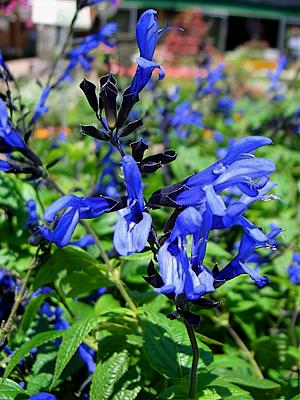 Salvia guaranitica 'Black and 'Blue'Mealy Blue Sage, Mealy Sage, Mealycup Sage, Blue Sage (Salvia farinacea) is a much branched perennial herb native to Mexico, New Mexico and Texas. There are several garden cultivars that differ in size and flower colour. Cultivars can be as small as +-30cm to as tall as 1.2m.
Salvia guaranitica 'Black and 'Blue'Mealy Blue Sage, Mealy Sage, Mealycup Sage, Blue Sage (Salvia farinacea) is a much branched perennial herb native to Mexico, New Mexico and Texas. There are several garden cultivars that differ in size and flower colour. Cultivars can be as small as +-30cm to as tall as 1.2m.
Blou Salie 'Victoria' (Salvia farinacea) is a small evergreen perennial with long green leaves, which may, or may not have teeth. It produces beautifully showy deep blue flowers on +-50 to 60cm tall spikes, and +-30 to 40cm wide plants. This salvia will bloom from spring until autumn if the dying flowers are kept trimmed off. It is hardy to moderate frost but is grown as an annual in very cold regions.
Salvia Mystic 'Spires Blue' (Salvia longispicata x farinacea) is a small evergreen perennial with a compact, upright growth habit. It blooms from spring all the way through to autumn; and the dark grey-green leaves are a perfect foil for the showy purple-blue flowers. This sage grows +-40cm tall and +-30cm wide, and is hardy to moderate frost.
Anise Sage 'Black and Blue' (Salvia guaranitica) is a lovely evergreen perennial which is native to Brazil, Paraguay and northern Argentina. It has an open habit, growing about 1 to 1.5m tall and can spread as wide; and the common name anise sage refers to the sweetly scented leaves, which release their aroma with even the slightest touch. The startlingly bright, cobalt-blue flower spikes are framed by black calyces and stems; and appear from mid-summer and continue deep into autumn. This salvia is a wonderful background plant, creating a brilliant display in landscapes and flower borders. It is easily cultivated as a summer annual and is hardy to moderate frost, as long as the roots are mulched in winter and it is planted in a protected position in the garden.
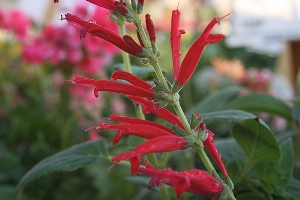 Pineapple SagePineapple Sage, Pynappelsalie (Salvia elegans) is a perennial shrub that is native to the highlands of Mexico and Guatemala. In late summer when it is in full bloom it is simply spectacular, with its masses of tubular, blood red flower spikes that contrast perfectly against the bright green leaves. The leaves have a wonderful fresh pineapple scent when crushed. It is also known for its healing properties and its name means 'to save or heal'. Its fragrant, pineapple flavoured leaves and edible flowers are added to fruit salads, cakes, vinegars and herb butters. Pineapple Sage is delicious if used with Citrus fruits and is included in fruit or wine cocktails. It is also excellent with fatty meats like pork, pasta, stuffing, gravies, stocks and cheese sauces. Mass plantings of Pineapple Sage will create a striking splash of colour, but even single specimens look great in the shrub or perennial border. It also grows well in larger pots if it is clipped regularly and the soil is very well drained. Pineapple sage is an evergreen perennial plant that is tender to frost, but will tolerate moderate frost if planted in a protected position in the garden. In severe frost regions it will die down completely in winter and grow back the following spring, as long as the roots are mulched in winter to keep the soil from freezing. It loves full sun and grows best in fairly rich, light, dry, well drained alkaline soil, but will adapt to most garden soils with good drainage. It grows +-90cm tall and 1m wide.
Pineapple SagePineapple Sage, Pynappelsalie (Salvia elegans) is a perennial shrub that is native to the highlands of Mexico and Guatemala. In late summer when it is in full bloom it is simply spectacular, with its masses of tubular, blood red flower spikes that contrast perfectly against the bright green leaves. The leaves have a wonderful fresh pineapple scent when crushed. It is also known for its healing properties and its name means 'to save or heal'. Its fragrant, pineapple flavoured leaves and edible flowers are added to fruit salads, cakes, vinegars and herb butters. Pineapple Sage is delicious if used with Citrus fruits and is included in fruit or wine cocktails. It is also excellent with fatty meats like pork, pasta, stuffing, gravies, stocks and cheese sauces. Mass plantings of Pineapple Sage will create a striking splash of colour, but even single specimens look great in the shrub or perennial border. It also grows well in larger pots if it is clipped regularly and the soil is very well drained. Pineapple sage is an evergreen perennial plant that is tender to frost, but will tolerate moderate frost if planted in a protected position in the garden. In severe frost regions it will die down completely in winter and grow back the following spring, as long as the roots are mulched in winter to keep the soil from freezing. It loves full sun and grows best in fairly rich, light, dry, well drained alkaline soil, but will adapt to most garden soils with good drainage. It grows +-90cm tall and 1m wide.
Read more about pineapple and culinary sage (Salvia officinalis) in our herb section. 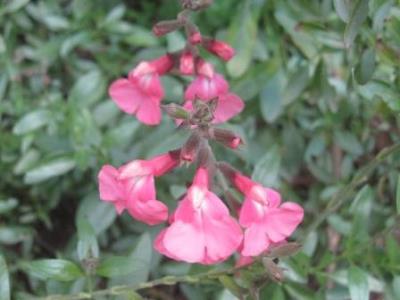 Salvia greggii 'Coral Pink' Picture courtesy www.steyns-nursery.co.zaCultivation:
Salvia greggii 'Coral Pink' Picture courtesy www.steyns-nursery.co.zaCultivation:
Salvias do well in most of our growing regions and perform extremely well in hot gardens. Although they are drought tolerant, to look at their best they should be watered moderately during long hot and dry spells. They thrive in full sun but will take light shade; and in regions which experience extremely hot weather, the plants will appreciate some shade during the hottest time of the day. Although there are salvias suitable for almost all climates, take care when choosing them because not all salvias are hardy in all regions, and extreme frost is fatal to them. Moderate frost may damage them but they usually recover quickly with the onset of warmer weather, as long as they are planted in a protected position in the garden and their roots are mulched in winter. For this reason, with the exception of those frost-free and humid regions, salvias are often grown as summer annuals.
Salvias can usually tolerate brackish (salty) water and grow well in sandy loam soils with perfect drainage, but will adapt to most garden soils, but it is vital that the soil drains well to prevent root rot. For this reason they are difficult to cultivate in heavy clay soils. Salvias are not hungry plants and overly fertile soils, or too much fertiliser will actually reduce flowering, so feed only once a season in spring, and mulch the roots with fresh compost; this will be sufficient fertilisation to see your plants through the season.
If you cut back your plants back lightly after each flush of flowers, new growth will soon emerge, and your plants will bloom almost continually. Just before winter sets in is the best time to prune them back sharply and to renew the organic mulch around their root systems if you want to protect them from the cold.
Propagation:
Annual salvia's are very easy-to-grow and can be sown directly into well-prepared garden beds or seedling trays in spring and summer. Cuttings also root easily and can even be rooted in water.
Perennial salvias set seed readily and sometimes surprises occur in the garden, with volunteer plants popping up if you failed to deadhead the blossoms before seed formation occurred, and you may discover hybrid offspring that look different from the parent plants, due to cross-pollination.
Perennial salvias are also easy to propagate from, stem cuttings taken in summer or root cuttings. Stems which fall down and touch the ground will also root where they touch the ground.
Pests & Diseases:
If grown correctly sage suffers from few pests and diseases, but in waterlogged soil it is susceptible to root rot and wilt. Watch out for snails and slugs, as well as red spiders during hot dry spells.
Caution:
Garden salvias are all considered to be non-toxic to pets and humans, which isn't to say that some dogs (or people, for that matter) won't have an allergic reaction or get sick if they eat sufficient leaves. Salvia divinorum is known for its hallucinogenic properties, but this salvia is a Mexican native that isn't very ornamental and is not sold in the gardening trade.


